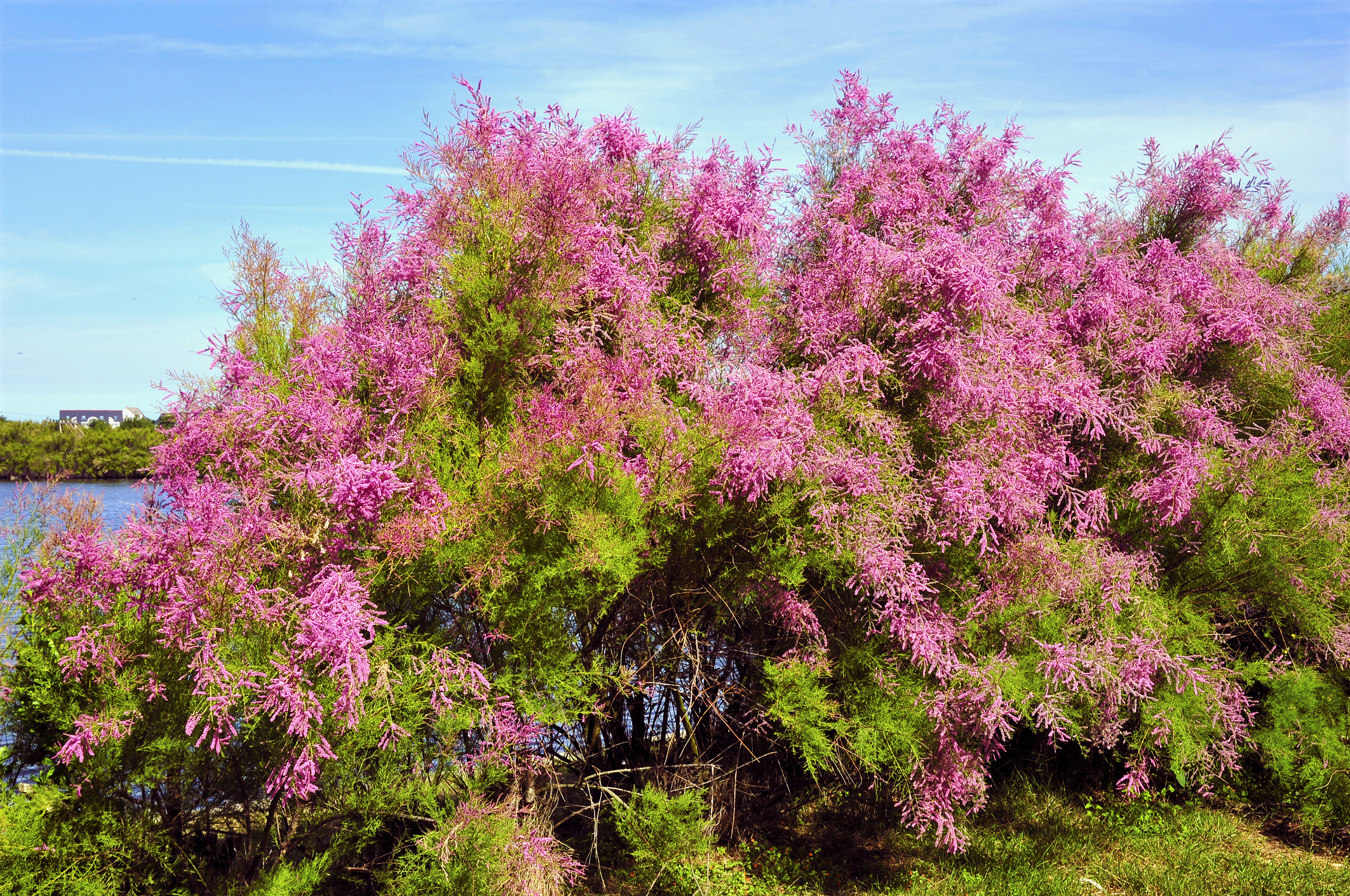
Red tamarix tree blooming in French Brittany
Tamarisk, a resilient shrub with a complex history, emerges as a botanical protagonist in the narrative of human interaction with the environment. From ancient uses rooted in practicality to unintentional introductions shaping ecosystems, Tamarisk’s story is intertwined with both human practices and ecological dynamics. This unassuming plant, known for its hardiness and adaptability, has left an indelible mark on historical landscapes, river ecosystems, and cultural narratives. Join us on a journey through time as we explore the multifaceted role of Tamarisk, from erosion control to unintended invasiveness, unveiling the historical chapters that have shaped our understanding of this remarkable botanical entity.
Ancient Utilization: Tamarisk boasts an ancient legacy, finding utility across diverse domains. In the annals of history, this hardy shrub or small tree was revered for its versatility. Ancient civilizations harnessed its potential for fuel, utilizing its wood for fires, while also incorporating it into construction projects. Additionally, Tamarisk held a place in traditional medicine, as various cultures explored its medicinal properties, contributing to its significance in historical pharmacopoeias.
Scientific Classification: Tamarisk, scientifically classified under the genus Tamarix and family Tamaricaceae, has been a subject of botanical exploration and classification. Over the years, scientists have meticulously studied its morphology, genetics, and ecological characteristics, placing it within the broader context of plant taxonomy.
Historical Range: With a historical presence stretching across regions along the Mediterranean and into Central Asia, Tamarisk shaped landscapes and ecosystems. Its adaptive qualities allowed it to thrive in different climates, making it a prominent feature in historical landscapes and influencing local environments.
Introduction to the Americas: The 19th-century introduction of Tamarisk to the Americas reveals a historical chapter in botanical globalization. Initially brought for erosion control and ornamental purposes, Tamarisk’s journey to the Americas showcases the unintended consequences of introducing non-native species, as it later became invasive in some regions, altering ecosystems and water availability.
Salt Tolerance: Tamarisk’s exceptional salt tolerance has historical implications, making it a resilient species in environments with high soil salinity. This adaptability has been harnessed for land reclamation in saline soils, showcasing the plant’s historical role in ecological restoration.
Water Management: Historical applications of Tamarisk for water management underscore its role in addressing environmental challenges. Planting Tamarisk in waterlogged soils for its capacity to absorb excess water exemplifies historical ecological engineering practices, demonstrating an early understanding of the plant’s hydrological impact.
Historical Plantations: In the late 1800s, historical plantations of Tamarisk were established in the American West, marking a deliberate effort to harness its benefits for windbreaks and erosion control. This historical initiative reveals the human fascination with Tamarisk’s adaptability and its potential to address environmental concerns in arid and semi-arid regions.
Control Efforts: As the invasive nature of Tamarisk became apparent, historical efforts to control its spread gained momentum. These initiatives reflect the ongoing struggle to manage invasive species and restore balance to ecosystems affected by the encroachment of non-native vegetation.
Historical Uses by Indigenous People: Indigenous communities historically engaged with Tamarisk, utilizing it for crafting tools and baskets. This historical connection between Tamarisk and indigenous cultures highlights the plant’s role in traditional practices and local economies.
Historical Records of Introduction: Historical records documenting the intentional introduction of Tamarisk to regions like the United States provide insights into the human-driven processes that have shaped ecosystems. The deliberate translocation of Tamarisk for specific purposes, combined with the unintended consequences that followed, reveals a nuanced interplay between human activities and ecological dynamics in history.
Invasive Characteristics: Tamarisk’s historical reputation for invasive characteristics is pivotal in understanding its ecological impact. Known for its rapid spread and aggressive colonization of habitats, Tamarisk altered the dynamics of ecosystems, outcompeting native vegetation. The historical study of these invasive traits contributes to broader discussions on the ecological consequences of introduced species and the challenges associated with managing invasive flora.
Historical Erosion Control: Tamarisk earned historical recognition for its role in erosion control along riverbanks and other vulnerable areas. Its deep root system helped stabilize soil, preventing erosion and protecting valuable land. This historical application showcases Tamarisk’s contribution to environmental conservation efforts, especially in regions susceptible to soil degradation.
Firewood and Timber: Historically, Tamarisk served as a practical resource for firewood and, in certain cases, as a timber source. Its hard wood made it suitable for these purposes, demonstrating the plant’s dual role as both a utilitarian and ecological component in historical human-plant interactions.
Historical Mention in Literature: References to Tamarisk in historical literature and texts provide glimpses into the cultural and ecological significance attributed to the plant. Literary mentions capture the plant’s presence in various cultural narratives, shedding light on how societies perceived and interacted with Tamarisk throughout history.
Efforts for Biological Control: Historical efforts to manage Tamarisk’s invasive spread involved innovative approaches, such as introducing specific insects that feed on the plant. These biological control measures, rooted in historical ecological strategies, aimed to rebalance ecosystems by targeting Tamarisk without resorting to chemical interventions.
Historical Impact on Water Resources: Tamarisk’s historical association with altering water availability in some regions reflects its water consumption patterns. The plant’s impact on river ecosystems and water tables, as documented throughout history, raises awareness about the interconnectedness of vegetation and hydrological systems.
Hybridization Studies: Scientific studies exploring hybridization between different Tamarisk species provide historical insights into the genetic diversity of the plant. These studies contribute to our understanding of Tamarisk’s evolutionary history and the potential implications for its adaptability in changing environments.
Historical Legislation for Control: Historical legislation enacted in some regions to control the spread of Tamarisk emphasizes the recognition of its ecological impact. Such legislative measures underscore the need for proactive management to mitigate the effects of invasive species on native ecosystems.
Historical Cultural Uses: Beyond its practical uses, Tamarisk held historical cultural significance. Symbolizing endurance and adaptability, the plant became intertwined with cultural practices, narratives, and symbolism, contributing to its multifaceted role in historical societies.
Historical Drought Resistance: Tamarisk’s historical resilience in arid and water-scarce environments highlights its drought-resistant qualities. As societies historically grappled with water scarcity, Tamarisk’s ability to thrive in such conditions added to its appeal as a sustainable and adaptive resource.
Historical Impact on Riparian Areas: Tamarisk’s historical impact on riparian areas is a crucial aspect of its ecological narrative. The plant’s presence along riverbanks altered habitat conditions, influencing soil composition, water dynamics, and the overall biodiversity of these sensitive ecosystems. The historical documentation of Tamarisk’s influence on riparian areas contributes to our understanding of its complex interactions with aquatic environments.
Historical Restoration Efforts: Historical efforts to restore native vegetation by removing Tamarisk underscore the ecological challenges posed by invasive species. These restoration initiatives represent a commitment to preserving biodiversity and ecosystem integrity, acknowledging the need to reverse or mitigate the impacts of Tamarisk on native flora and fauna.
Historical Plant Morphology Studies: Historical botanical studies delving into the morphology and reproductive characteristics of Tamarisk have been instrumental in shaping our understanding of the plant’s biology. Through detailed examinations of its physical attributes, historical researchers have contributed to the broader field of plant science, offering insights into Tamarisk’s adaptation strategies and reproductive strategies.
Historical Ecological Changes: The historical spread of Tamarisk has led to ecological changes in various landscapes. Documented alterations in nutrient cycles, species composition, and ecosystem structure highlight the far-reaching consequences of Tamarisk’s introduction to new environments. Historical perspectives on these ecological changes aid in crafting strategies for conservation and ecological restoration.
Historical Herbicidal Applications: Historical use of herbicides to control Tamarisk populations reflects human efforts to address the challenges posed by invasive species. The application of herbicides in history exemplifies the ongoing struggle to find effective and sustainable means of managing Tamarisk and mitigating its impact on ecosystems. These historical herbicidal applications contribute to the broader dialogue on invasive species management and environmental conservation.









